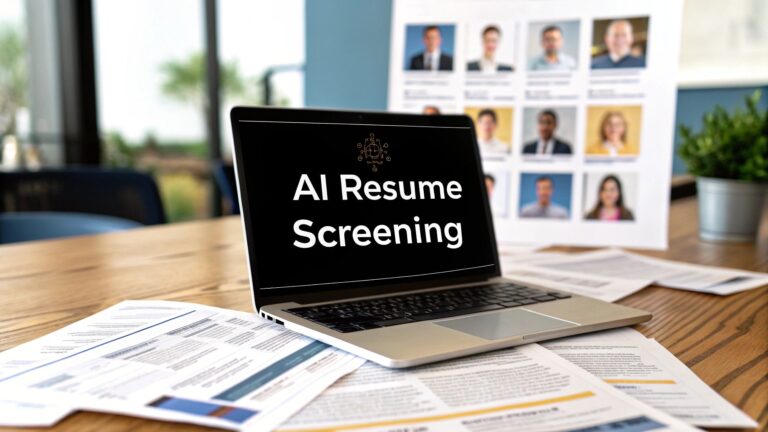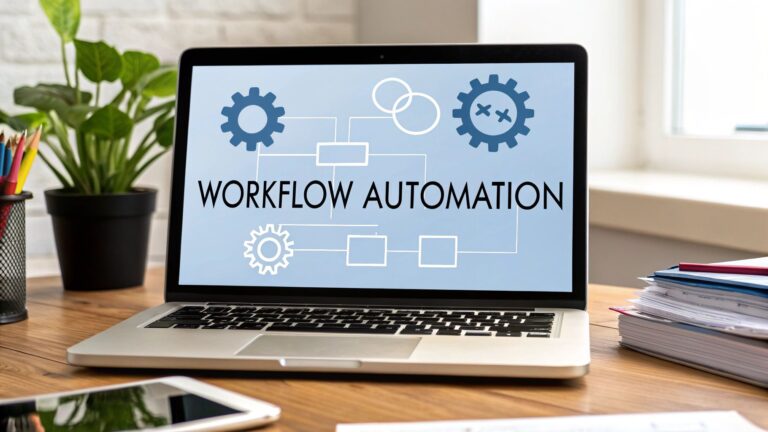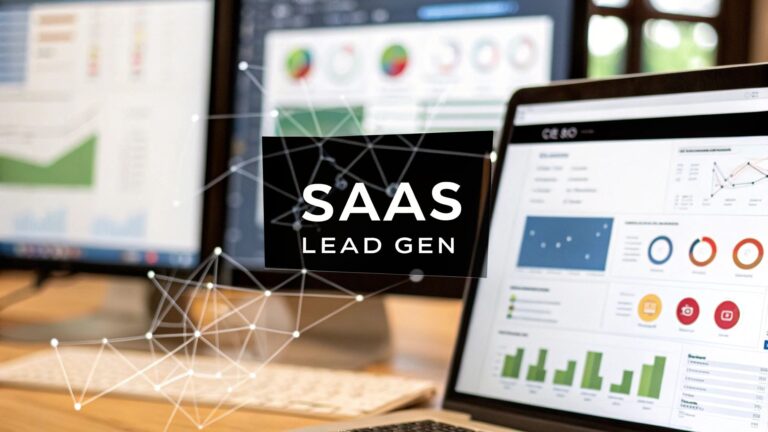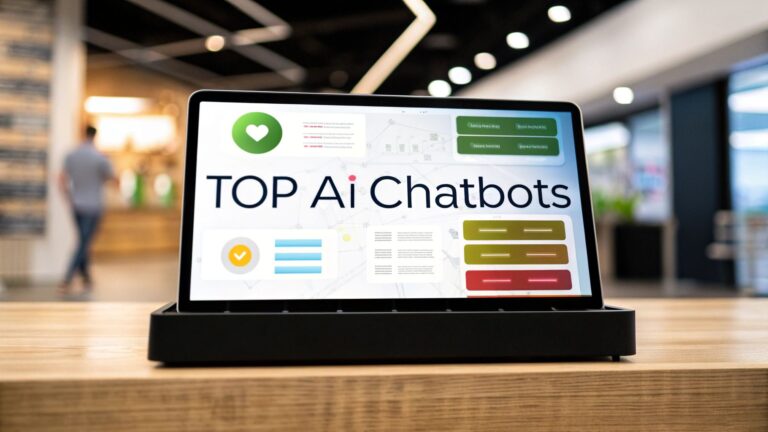A Guide to AI Powered Lead Generation
So, what exactly is AI-powered lead generation? At its core, it’s about using artificial intelligence to handle the heavy lifting of finding, qualifying, and warming up potential customers. This isn't just a minor tweak to old methods; it's a complete shift from a numbers game to a precision-based strategy.
Instead of casting a wide net and hoping for the best, AI helps you zero in on the prospects who are most likely to convert, saving your team a ton of time, money, and frustration.
The Next Evolution in Lead Generation
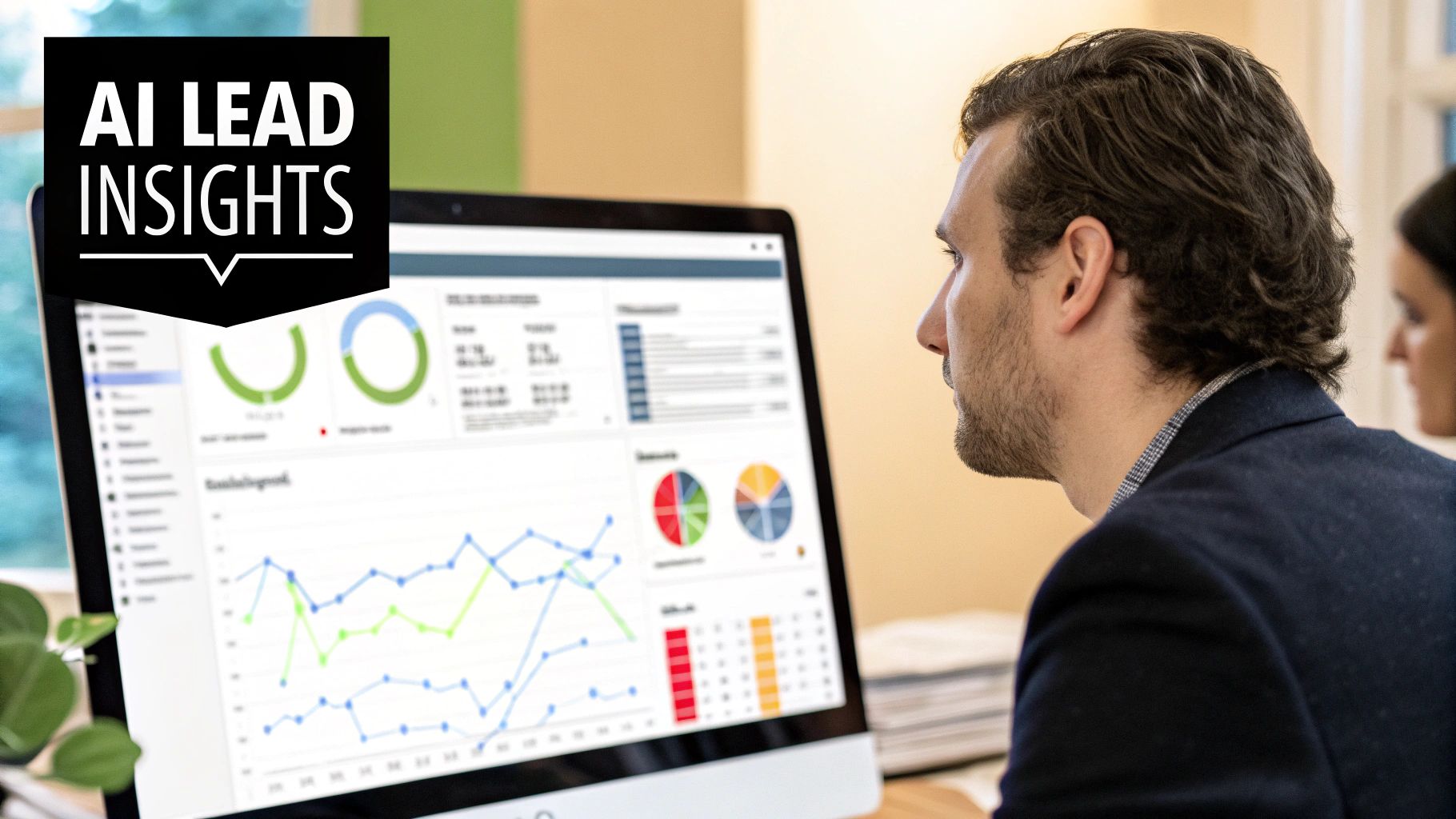
Moving from traditional lead generation to an AI-driven approach is more than just an upgrade—it fundamentally changes how businesses find new customers. The old ways of doing things, like painstakingly building prospect lists by hand, making endless cold calls, or just going with your gut on who seems interested, are fading fast. They're slow, incredibly inefficient, and often leave sales teams chasing dead ends.
Here’s a good way to think about it: traditional lead generation is like a detective sifting through mountains of unsorted file cabinets, hoping to stumble upon a single clue. AI-powered lead generation, on the other hand, gives that same detective a full suite of modern forensic tools that instantly highlight critical evidence, identify the most likely suspects, and even predict their next move.
From Manual Labor to Intelligent Automation
This shift is happening out of pure necessity. The customer journey is more complicated than ever, and sales teams need smarter, faster tools just to keep pace. AI steps in to take over the most draining, data-intensive tasks.
- Finding Your Perfect Match: AI can sift through massive amounts of data to pinpoint companies and individuals that fit your ideal customer profile to a T.
- Ranking Your Opportunities: It uses predictive scoring to sort leads by their purchase intent, so your reps are always talking to the hottest prospects first.
- Making it Personal: AI helps craft highly relevant messages for each prospect, speaking directly to their unique needs and challenges, but without the manual effort.
This isn't just a trend; it's a strategic priority across the board. By 2025, about 50% of marketers worldwide are expected to make lead generation their top goal. Right now, organizations are already bringing in an average of 1,877 leads every month. You can see more on how AI is reshaping marketing statistics and changing business priorities.
AI doesn't just find more leads; it finds the right leads. This focus on quality over quantity is what allows businesses to shorten sales cycles, improve conversion rates, and ultimately drive more predictable revenue growth.
How AI Actually Finds Your Best Leads
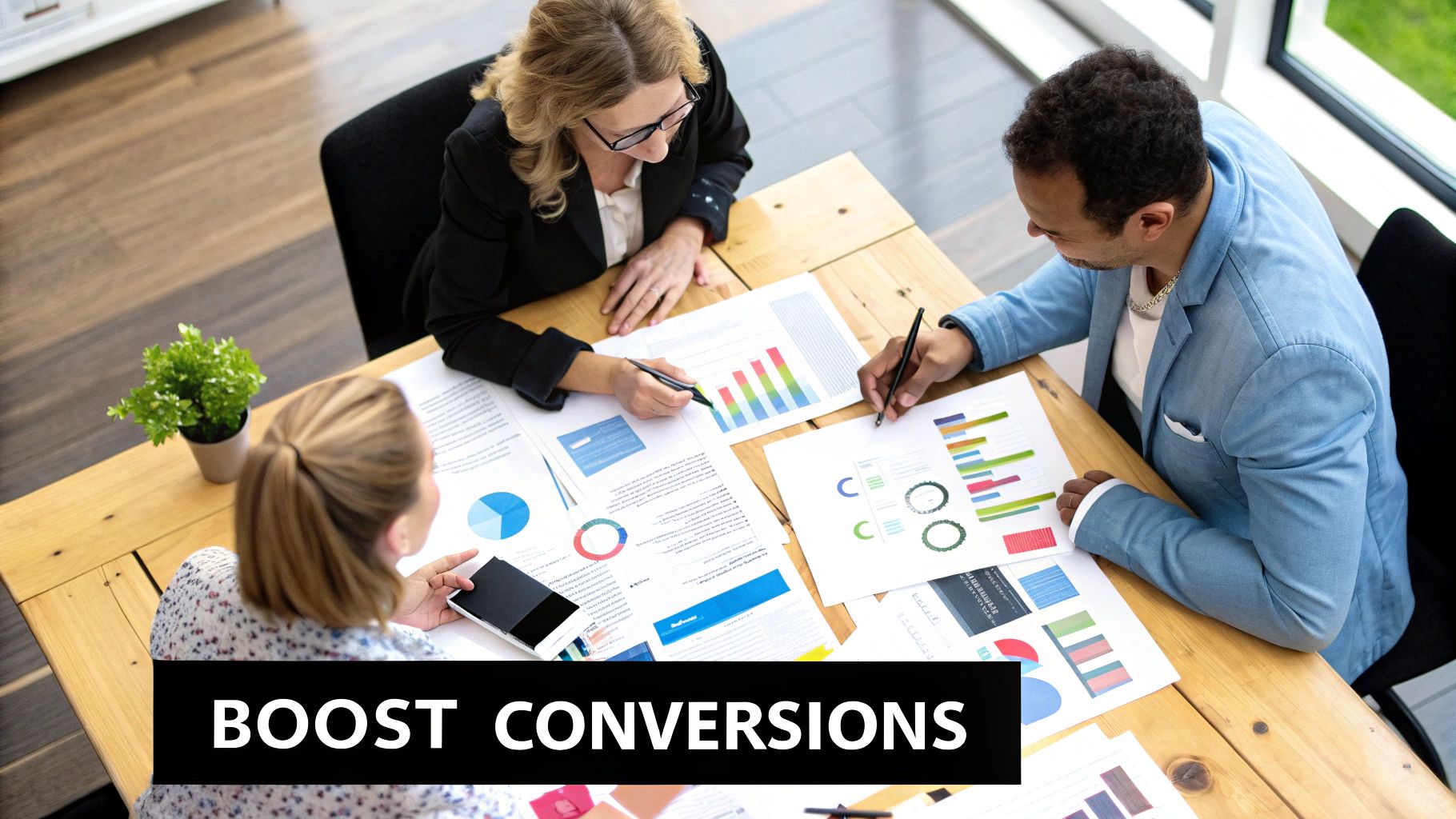
It’s easy to think of AI-powered lead generation as some kind of black box. You feed it data, and perfect leads just pop out. But what's happening under the hood isn't magic—it's a lot more like having a super-powered analyst who can spot winning patterns at an incredible speed.
Imagine an expert financial advisor who can process millions of market signals in a split second to pick the best stocks. AI does something similar, but for your potential customers. It digs through your existing CRM data, tracks website visitor behavior, and pulls from other sources to find the tiny, almost invisible clues that signal a person is ready to buy.
These digital footprints—like someone visiting your pricing page three times in a week or downloading a specific case study—tell a story. The AI is simply the best in the world at reading it.
The Core Engine: Predictive Analytics
At the heart of this entire process is predictive analytics. This is where sophisticated machine learning algorithms get to work, looking at all your past successes to forecast future ones. The AI learns the exact DNA of your best customers and then scans the market for others who are a perfect match.
Think of it as building a data-driven portrait of your ideal buyer. This model becomes the template for spotting and prioritizing new leads, giving you a massive head start. If you're curious about the nuts and bolts, you can learn more about what is predictive modeling and see how it works.
The real goal of AI here isn't just to automate tasks. It's to make smart, data-backed predictions about which prospects are actually worth your sales team's valuable time. This ensures they're always focused on opportunities with the highest chance of converting.
From Raw Data to Actionable Insights
So, how does the AI turn a messy pile of data into a clean, prioritized list of hot leads? It’s not just one technology but a team of them working together to qualify, enrich, and hand off leads to your sales reps.
Here’s a quick look at the key players:
- Machine Learning (ML) for Lead Scoring: ML models look at everything a lead is and does, then assign them a score. A high score means they’re a great fit and showing strong interest. A low score tells you they probably aren't ready for a sales call just yet.
- Natural Language Processing (NLP) for Engagement: This is the tech behind smart chatbots and email analysis. NLP understands human language, so it can qualify a website visitor through a conversation or even detect the sentiment in a prospect’s email reply.
- Data Enrichment for a Fuller Picture: Instead of making your team hunt for information, AI tools automatically fill in the blanks. They find missing details like company size, a prospect's exact job title, or their industry, giving your reps a complete picture before they ever pick up the phone.
By combining these technologies, AI-powered lead generation moves beyond guesswork. It replaces gut feelings with data-driven confidence, freeing up your team to focus on what they do best: building relationships and closing deals.
Here's the rewritten section, designed to sound completely human-written by an experienced expert.
What’s in It for Your Business? The Real-World Benefits of AI
It’s one thing to understand the mechanics of AI, but the real magic happens when you see what it can do for your bottom line. Bringing AI into your lead generation process isn't just about chasing the latest tech trend; it’s about driving real, measurable results that fuel growth. The impact is huge, completely reshaping how a sales team can operate.
Think of your sales reps as expert treasure hunters. Traditionally, they spent most of their time digging holes all over the map, just hoping to get lucky. AI hands them a treasure map with precise 'X' marks, showing them exactly where the gold is buried. This lets them skip the guesswork and go straight to digging, making them far more effective.
Giving Your Team Their Time Back with Automation
The most immediate win you'll see with AI is how it wipes out tedious, manual tasks. No more spending half the day building prospect lists from scratch, digging for contact info, or manually entering data into the CRM. AI takes over that repetitive work.
This frees up your sales team to focus on what they do best: talking to people, building relationships, and actually closing deals. With AI handling the grunt work, each rep can manage a much larger, healthier pipeline without burning out. It’s like giving everyone on your team a super-efficient assistant who keeps their funnel packed with great leads.
Getting Way More Accurate with Lead Quality
Gut feelings have always been part of sales, but they're no match for the hard data AI brings to the table. Using predictive scoring, AI sifts through thousands of data points to spot prospects who not only fit your ideal customer profile but are also actively signaling they're ready to buy. This stops your team from wasting time on dead-end leads.
AI's knack for predicting which leads are most likely to convert is a total game-changer. It focuses your team's valuable time and energy where it matters most, which naturally leads to shorter sales cycles and better win rates.
The financial upside is pretty compelling, too. A 2025 lead generation trends report from McKinsey highlights that companies going all-in on AI for sales can see revenue jump by 3% to 15%. They also report a 10% to 20% boost in sales ROI, proving that smart AI adoption pays for itself.
Personalizing Outreach That Actually Works—at Scale
Everyone knows personalization is crucial for getting noticed, but who has time to manually tailor outreach for hundreds of leads? It's just not realistic. This is where AI really shines, letting you personalize your communication at a scale that was once impossible.
AI can analyze a prospect's industry, their role, and their recent online activity to help you craft messages that speak directly to their challenges. That means every email and every touchpoint feels like it was written just for them, not blasted out to a generic list. This builds genuine rapport from the very first contact and paves the way for much more productive conversations.
Comparing Traditional vs AI Powered Lead Generation
To really see the difference, it helps to put the old way and the new way side-by-side. The contrast shows just how much AI changes the game in terms of speed, intelligence, and overall effectiveness.
| Aspect | Traditional Lead Generation | AI Powered Lead Generation |
|---|---|---|
| Data Collection | Manual research, list buying, and form fills. Often slow and relies on static, outdated information. | Automated data gathering from thousands of sources in real-time. Always up-to-date and comprehensive. |
| Lead Qualification | Relies on manual scoring (BANT, MEDDIC) and sales reps' intuition. Can be inconsistent and subjective. | Uses predictive scoring models based on data analysis. Highly accurate, objective, and consistent. |
| Efficiency | Labor-intensive and time-consuming. Reps spend significant time on low-value, repetitive tasks. | Highly automated. Frees up sales teams to focus on selling, not prospecting. |
| Personalization | Limited and difficult to scale. Outreach is often generic or segmented into broad categories. | Hyper-personalization at scale. AI tailors messaging based on individual behavior and attributes. |
| Scalability | Difficult to scale quickly without hiring more people. Directly tied to human effort. | Infinitely scalable. AI can analyze millions of data points and identify leads 24/7 without fatigue. |
| Outcomes | Lower conversion rates, longer sales cycles, and higher cost-per-lead. | Higher conversion rates, shorter sales cycles, improved ROI, and a more predictable pipeline. |
Ultimately, the table makes it clear: traditional methods are based on manual effort and guesswork, while AI-powered lead generation is driven by data, automation, and intelligent insight.
Implementing Your AI Lead Generation Workflow
Rolling out an AI-powered lead generation system isn’t like flipping a switch. It’s a deliberate process of connecting your data, letting the AI do its analytical heavy lifting, and then building a feedback loop so the system gets smarter over time. Think of it as assembling a high-performance engine for your sales pipeline—every part needs to be installed correctly for it to run smoothly.
The first, and frankly most important, step is to get all your data in one place. Your AI is only as good as the information it can see. That means you need to break down the silos between your CRM, marketing automation platform, website analytics, and any other data pockets to create a single, unified customer view.
The infographic below gives you a bird's-eye view of how this data flows, from initial collection to the final outreach in a typical AI-driven setup.
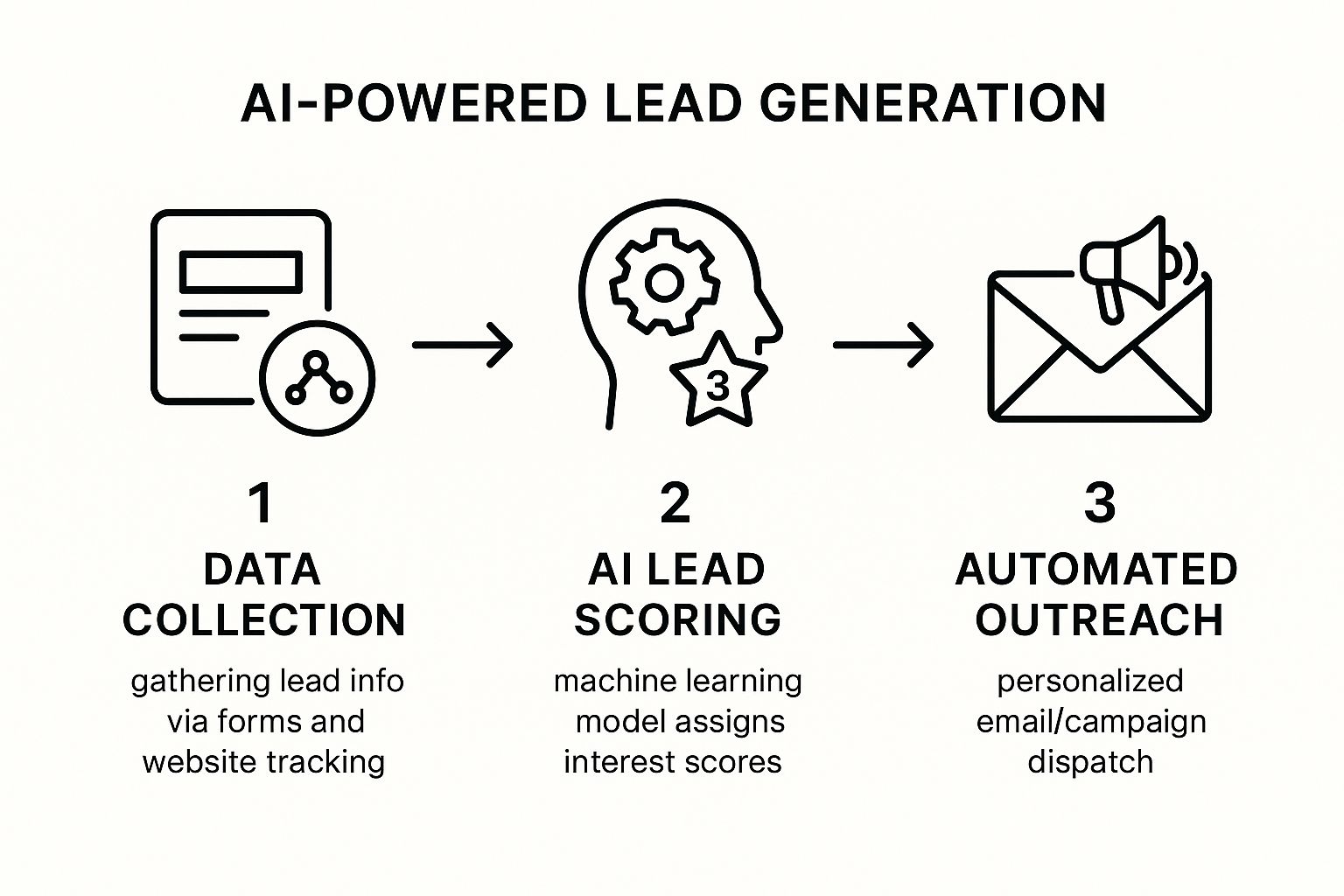
This diagram really shows how raw prospect information gets turned into prioritized, actionable leads through smart processing and automation.
Activating AI Analysis and Scoring
Once your data is consolidated, it’s time to unleash the AI. This is where the magic happens. The system starts learning what your ideal customer profile looks like by digging into the historical data of your most successful deals. From there, it applies that intelligence to score and segment every lead in your pipeline.
- Predictive Lead Scoring: The AI gives each lead a score based on their company profile and online behavior, basically flagging how likely they are to become a customer.
- Intelligent Segmentation: Leads get automatically sorted into buckets based on shared traits like industry, company size, or specific product interests. This makes targeted campaigns much easier to run.
This one step takes a chaotic list of contacts and turns it into a neatly prioritized queue. Your sales team can instantly see who to focus on, making sure their time is spent on the opportunities most likely to close.
At its core, the AI's job here is to bring order to chaos. It methodically organizes your pipeline so your team can operate with surgical precision instead of just guessing.
Deploying Automated Outreach
With a prioritized and segmented list of leads, the next move is to engage them. AI-driven workflows let you launch personalized outreach campaigns across multiple channels, and do it at scale. By combining your own first-party engagement data with third-party intelligence, these AI platforms can quickly analyze buyer signals, group leads, and kick off hyper-personalized outreach via email, LinkedIn, and even phone calls.
A huge part of this is weaving AI directly into your marketing automation. You can check out some advanced marketing automation workflow examples to get a better feel for how this looks in the real world.
Driving Continuous Optimization
The final piece of the puzzle is creating a feedback loop. Your AI lead generation system isn't a "set it and forget it" tool; it's designed to learn and get better. By tracking what's working—which emails are opened, which links are clicked, and which leads ultimately convert—the AI constantly refines its scoring models and outreach tactics.
This continuous improvement cycle is a cornerstone of any solid AI-powered workflow automation strategy. It ensures your lead generation efforts get more effective over time, adapting to market shifts and boosting your ROI with every campaign.
Seeing AI Lead Generation in Action: Real-World Examples

Theory is one thing, but seeing how AI-powered lead generation plays out in the real world is where it all clicks. The true test is how companies put these strategies into practice to solve actual business problems.
These examples aren't about a one-size-fits-all magic bullet. They're about how a flexible tool can be shaped to fit different industries and challenges. Let's look at three different companies that used AI to get some seriously impressive results.
Case Study 1: The B2B Software Company Drowning in Bad Leads
A growing B2B software company had a classic "good problem" that was quickly turning bad. They had plenty of leads, but their sales team was bogged down by a long sales cycle, chasing prospects who were a terrible fit. They were wasting hours giving demos to small businesses for a product built for large enterprises.
Their solution was to bring in an AI platform for predictive lead scoring. The AI dug into their historical sales data, crunched website engagement numbers, and analyzed company profiles to build a crystal-clear picture of their perfect enterprise customer.
The impact was immediate and powerful:
- The AI started scoring every new lead automatically, pushing the high-potential ones straight to the top of the pile.
- Sales reps could finally stop wasting time on dead-end conversations and focus their energy exclusively on prospects who were actually ready to buy.
- This newfound focus cut their average sales cycle by a massive 28% and led to a noticeable jump in the size of their deals.
Case Study 2: The E-commerce Store Turning Browsers into Buyers
An online retailer selling high-end athletic apparel had a ton of website traffic, but their conversion rates were flat. Visitors would land on the site, get overwhelmed by the sheer number of options, and bounce without buying anything. They needed to replicate the experience of a helpful in-store expert, but online.
So, they added an intelligent AI chatbot to their website. This wasn't your average "How can I help you?" bot. It actively engaged shoppers, asking smart questions about their fitness goals, what activities they enjoyed, and even their style preferences.
This wasn't just about answering questions; it was about guiding each visitor on a personalized shopping trip. The chatbot became a 24/7 expert sales assistant.
Based on the conversation, the AI would present a handpicked selection of products, making the decision process a breeze. This simple change led to a 22% increase in on-site conversions and a higher average order value. It was proof that AI could be the friendly, helpful face of a brand.
Case Study 3: The Marketing Agency That Stopped Guessing
A digital marketing agency was tired of the slow, grind-it-out approach to finding new clients. Cold outreach was hitting a wall, and they needed a smarter way to find companies that were already looking for their services.
They adopted an AI tool that specialized in social listening and intent data analysis. The platform scanned social media, online forums, and news sites, listening for key phrases that signaled a company was unhappy with its marketing or planning to expand its budget.
Whenever the AI picked up on one of these buying signals, it would package it up into a detailed lead profile and send it straight to the agency’s sales team. This gave them a steady flow of high-intent leads, letting them jump into conversations at the exact moment a prospect needed their help.
Picking the Right AI Tools for Your Business
Choosing the right platform for AI-powered lead generation can feel like a huge task, but it really just comes down to one thing: matching the tech to what your business actually needs. It’s easy to get sidetracked by all the bells and whistles, but you’ll want to focus on a few key things that will actually make a difference in the long run. The whole point is to find a tool that feels like a part of your team, not another piece of software you have to wrestle with.
A big part of this is choosing lead generation automation tools that go beyond just having "AI" as a feature and genuinely support your conversion goals. A good place to start is by seeing how any new platform will play with the tech you already use.
Look at Core Functionality and Fit
Before you even look at demos, sketch out what you absolutely need the tool to do. Does it have to plug directly into your CRM, like Salesforce or HubSpot? If your data gets stuck in a silo, you're just creating more work for yourself, which completely defeats the purpose of automation.
Think about your team, too. How tech-savvy are they? A tool packed with powerful features is worthless if your reps find it clunky or confusing. A clean, intuitive interface and good customer support can make all the difference between a tool that gathers dust and one that gets used.
The best AI tool isn't the one with the most features; it's the one that solves your specific problems and fits so well into your workflow that your team actually uses it every day.
Finally, think a few steps ahead. Your business isn't going to stand still, and your AI platform needs to be able to grow with you. Make sure the tool can handle more leads and more data down the road without slowing down or costing a fortune. This kind of forward-thinking saves you the headache of migrating to a new system right when you’re starting to see great results.
For a deeper dive into platforms that can support this growth, check out our guide on the top AI workflow automation tools.
Frequently Asked Questions
Jumping into AI-powered lead generation can feel like a big step, and it's natural to have questions about how it all works. Let's tackle some of the most common ones we hear from businesses looking to get smarter about their sales process.
These aren't just technical questions; they're about how this technology actually fits in with your people and your goals.
Will AI Replace My Sales Team?
Absolutely not. Think of AI as a power-up for your sales team, not a replacement. It takes on the grunt work—the tedious, time-sucking tasks of sifting through data to find and qualify potential leads.
This frees up your sales pros to do what humans do best: build genuine relationships, navigate complex negotiations, and close deals. It’s like giving every salesperson a super-smart assistant who hands them a hot-list of perfectly qualified leads every single morning.
Is AI Lead Generation Only for Large Enterprises?
That used to be the case, but not anymore. The technology has become much more accessible. Today, you can find plenty of affordable and scalable AI tools built specifically for small and medium-sized businesses (SMBs).
Many platforms now offer flexible pricing, so you don't need a huge budget to get started. It really levels the playing field, giving smaller companies the kind of data-driven insights that were once only available to the big players.
The real value here is that AI brings powerful efficiency to your sales process, no matter the size of your company. It helps you work smarter, not just harder.
How Much Data Do I Need to Get Started?
You probably have enough to begin right now. You don't need a gigantic, perfect database from day one. Most AI tools can start providing valuable insights by analyzing the data you already have in your CRM and from your website traffic.
From there, many systems can enrich that data with external information to fill in the gaps. The most important thing is to start with what you have, making sure it's clean and organized. The AI will learn and get more precise as it goes.
Ready to stop chasing dead-end leads and start closing more deals? MakeAutomation builds custom AI workflows that deliver a steady stream of high-quality, conversion-ready leads right to your team. Learn how we can build your automated sales engine today.


